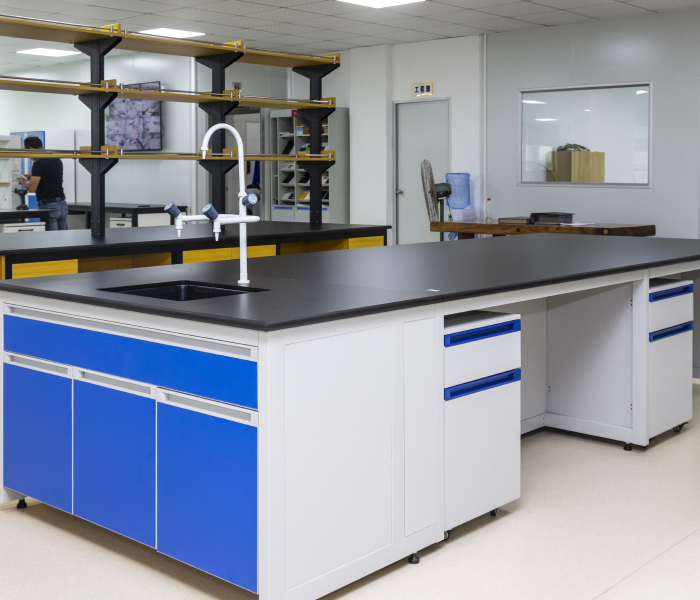Table of Contents
In high-risk work environments, where heavy equipment, hazardous materials, and intense experiments are part of daily operations, having the right lab furniture is crucial. One of the key features that many labs overlook when designing their workspace is impact resistance. For industries such as materials science, industrial testing, and chemical labs, impact-resistant lab furniture is a necessity. Not only does it enhance lab safety, but it also ensures the longevity of the equipment, reducing downtime and costly replacements.
Why Impact Resistance Matters in High-Risk Labs
Laboratories that handle heavy machinery, corrosive chemicals, or sharp tools need to prioritize durability. In these environments, accidents are more likely to happen—whether it’s a tool being dropped or a chemical spill—meaning the lab furniture must be able to withstand the impact. Impact-resistant lab furniture offers the following advantages:
- Enhanced safety: Strong, durable furniture reduces the risk of accidents caused by furniture failures, such as collapsing benches or broken surfaces.
- Cost efficiency: Instead of constantly replacing damaged furniture, investing in high-quality, heavy-duty lab furniture saves money over time.
- Protection for sensitive equipment: In high-risk environments, the furniture should protect the sensitive lab tools and machines placed on it, shielding them from damage during rough use or minor accidents.
Essential Features of Impact-Resistant Lab Furniture
When selecting lab furniture for high-risk environments, there are several critical features to look for. These features ensure that the furniture can withstand the tough conditions of an industrial or research-focused laboratory.
Reinforced Frames
The foundation of impact-resistant lab furniture is its frame. Look for options with reinforced steel or stainless-steel frames. These materials offer superior strength, allowing the furniture to carry heavy loads without bending or collapsing under pressure.
Tough, Resilient Surfaces
Work surfaces in high-risk labs should be made from impact-resistant materials like epoxy resin or phenolic resin. These surfaces are designed to withstand not just physical impact but also chemical spills and heat, which are common in industrial labs.
Heavy-Duty Casters and Leveling Feet
In environments where lab furniture needs to be mobile, having sturdy, heavy-duty casters ensures that furniture can be moved without damage. For stationary pieces, leveling feet with impact resistance can prevent wear and tear from constant usage in uneven flooring situations.
Scratch and Corrosion Resistance
Impact-resistant furniture should not only withstand blunt force but also be resistant to scratches, dents, and corrosive materials. Industrial labs, especially those working with chemicals, need surfaces that won’t degrade over time.
Industries That Require Impact-Resistant Lab Furniture
Certain industries rely heavily on lab furniture for high-risk environments to protect workers, equipment, and ongoing research. Below are some examples of where this type of furniture is essential:
- Materials Science Labs: In these labs, researchers often work with heavy equipment used to test the strength of different materials. Impact-resistant furniture ensures these tools are securely held and prevents damage during intensive testing.
- Industrial and Manufacturing Labs: Heavy machinery, production equipment, and robust testing devices make heavy-duty lab furniture a necessity in these settings.
- Chemical and Biological Laboratories: In labs that handle corrosive chemicals, volatile substances, or biological hazards, durable furniture reduces the risks posed by accidental spills or impacts.
- Government and Defense Research Facilities: These labs often handle dangerous materials and equipment that can be harmful if not properly managed. Impact-resistant furniture helps maintain safety and security for all workers involved.
Best Practices for Maintaining Durability
Even the most durable, impact-resistant lab furniture requires proper care and maintenance to ensure its longevity. Here are some best practices to follow:
Regular Inspections
Schedule routine checks to ensure that the furniture is in good condition. Look for signs of wear, especially on surfaces and frames, and replace or repair parts as needed.
Proper Cleaning Protocols
Use appropriate cleaning solutions that are non-corrosive to keep furniture surfaces free of chemicals or debris that could degrade the material. Follow manufacturer guidelines to avoid damaging the impact-resistant coatings.
Weight Limit Awareness
While impact-resistant furniture is designed to handle more than standard lab furniture, it’s essential to stay within the recommended weight limits. Avoid overloading benches or shelving to prevent unnecessary stress on the frames.
Utilize Protective Mats or Covers
For labs dealing with extreme materials or tools, consider using protective mats or covers on workbenches. This added layer can absorb some of the impact, helping to maintain the furniture’s integrity over time.
Conclusion
Choosing the right lab furniture is critical for high-risk work environments. By investing in impact-resistant lab furniture, labs can ensure the safety of their personnel, protect their equipment, and extend the lifespan of their furnishings. From reinforced frames to tough, resilient surfaces, these essential features provide the durability needed in industries where accidents are more likely to occur. By following best practices for maintenance, you can keep your lab running smoothly and efficiently, minimizing the risk of costly replacements or repairs.




